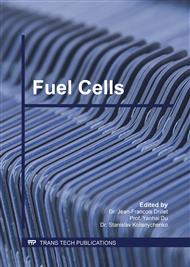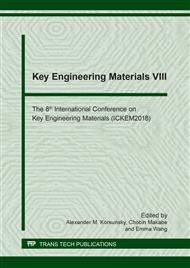[1]
V. Vonk, N. Khorshidi, A. Stierle, H. Dosch, Atomic structure and composition of the yttria-stabilized zirconia (111) surface, Surface Science 612 (2013) 69-75.
DOI: 10.1016/j.susc.2013.02.014
Google Scholar
[2]
N. Mahato, A. Banerjee, A. Gupta, S. Omar, K. Balani, Progress in material selection for solid oxide fuel cell technology: A review, Progress in Materials Science, 72 (2015) 141-337.
DOI: 10.1016/j.pmatsci.2015.01.001
Google Scholar
[3]
S. Tailor, M. Singh, A.V. Doub, Synthesis and Characterization of Yttria-Stabilized Zirconia (YSZ) Nano-clusters for Thermal Barrier Coatings (TBCs) Applications, Journal of Cluster Science 27 (2016) 1097-1107.
DOI: 10.1007/s10876-016-1014-y
Google Scholar
[4]
C. Peters, Grain-size Effects in Nanoscaled Electrolyte and Cathode Thin Films for Solid Oxide Fuel Cells (SOFC), KIT Scientific Publishing, (2009).
Google Scholar
[5]
T.H. Etsell and S.N. Flengas, Electrical properties of solid oxide electrolytes, Chemical Reviews 70 (1970) 339-376.
DOI: 10.1021/cr60265a003
Google Scholar
[6]
S.P.S. Badwal and K. Foger, Solid Oxide Electrolyte Fuel Cell Review, Ceramics International 22 (1996) 257-265.
DOI: 10.1016/0272-8842(95)00101-8
Google Scholar
[7]
J.Y. Paek, I. Chang, J.H. Park, S. Ji, S.W. Cha, A study on properties of yttrium-stabilized zirconia thin films fabricated by different deposition techniques, Renewable Energy 65 (2004) 202-206.
DOI: 10.1016/j.renene.2013.08.043
Google Scholar
[8]
M. Sayer and K. Sreenivas, Ceramic Thin Films: Fabrication and Applications, Science 247 (1990) 1056-1060.
DOI: 10.1126/science.247.4946.1056
Google Scholar
[9]
I. Corni, M. Ryan, A. Boccaccini, Electrophoretic deposition: From traditional ceramics to nanotechnology, Journal of the European Ceramic Society 28 (2008) pp.1353-1367.
DOI: 10.1016/j.jeurceramsoc.2007.12.011
Google Scholar
[10]
L. Besra, M. Liu, A review on fundamentals and applications of electrophoretic deposition (EPD), Progress in Materials Science 2 (2007) 1-61.
DOI: 10.1016/j.pmatsci.2006.07.001
Google Scholar
[11]
T. Ishihara, K. Sato, and Y. Takita, Electrophoretic Deposition of Y2O3-Stabilized ZrO2 Electrolyte Films in Solid Oxide Fuel Cells, Journal of American Ceramic Society 79 (1996) 913-919.
DOI: 10.1111/j.1151-2916.1996.tb08525.x
Google Scholar
[12]
F. Chen, M. Liu, Preparation of Yttria-stabilized Zirconia (YSZ) Films on La0.85Sr0.15MnO3 (LSM) And LSM-YSZ Substrates Using an Electrophoretic Deposition (EPD) Process, Journal of European Ceramic Society 21 (2001) 127-134.
DOI: 10.1016/s0955-2219(00)00195-3
Google Scholar
[13]
F.R. Bueta, J.F. Imperial, R.B. Cervera, Structure and conductivity of NiO/YSZ composite prepared via modified glycine-nitrate process at varying sintering temperatures, Ceramics International Journal 43 (2017) 16174-16177.
DOI: 10.1016/j.ceramint.2017.08.193
Google Scholar



